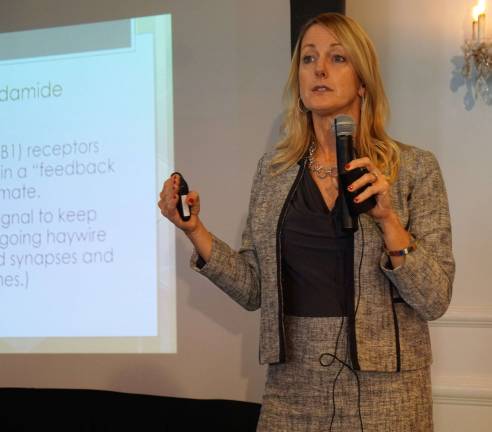Neuroscientist says keep pot from kids

VERNON — “However you think politically about legalization of marijuana, medical science strongly supports, we need to keep it out of the hands of kids,” said Neuroscientist Bonnie Nolan, at the Marijuana Potency, Policy, and Public Impact Summit.
She continued, “There is very good evidence suggesting cannabis use is detrimental to development.”
The brain is an amazing organ, Nolan said, which does not want or like to be high; it wants to achieve homeostasis — remain the same.
“If you try to force it into a different state,” she added, “it will down regulate the receptors, resulting in tolerance.”
Nolan said there are two “critical periods of development” for the human brain: conception to approximately two years of age and adolescence: 10 – 12 until 20 – 22. Nolan said, adolescence is a busier time for the brain which is critical to learning, emotions, hormonal responses, and risk taking behavior/impulses.
During the critical adolescent brain change to the prefrontal cortex (PFC), she said, — housing higher executive function, decision making, impulse control — brain pruning takes place.
Nolan said someone who smokes marijuana heavily throughout adolescence and interrupts the way the brain is pruned, will affect long-term behavior such as: cognition, verbal recall, consequence understanding, and the perception of passing time. In some rare cases, she added, with genetic predisposition, schizophrenia and lasting psychosis could occur.
Heavy use, she said, is at least once daily, based on their research using five percent THC level of marijuana, one of the active ingredients causing the “high.” “We don't know what will happen,” Nolan said, “with the higher levels of THC.”
THC binds preferentially to the CB1 brain receptors throughout the brain, Nolan said, thus, competing with anandamide. Anandamide monitors the pruning function of glutamate – a neurotransmitter in the central nervous system — crucial for learning.
Glutamate, Nolan said, serves a very important function in pruning. Pruning during the second critical period is constant, where synaptic connections related to behavioral outcomes/consequences are either strengthened or discarded.
She said, anandamide and CB1 receptors prevent glutamate from destroying good synapses and missing “bad” ones. Interfered pruning — by THC — can prevent maturity in an individual.
Nolan gave the example of a person with a 30 year-old brain having the emotional age of a 17 year-old. She added, nature does not care. The brain will not go back to re-enter the critical period and rewire everything.
Smoking heavily, Nolan said, changes the brain irreversibly in some cases. She added, “Alcohol also interferes with pruning and exacerbates the effects of cannabis on pruning.”
Deactivation of a very important part of the pruning mechanism, she said, can be temporary and reversible, but not indefinitely. It takes time — sometimes six months - for the receptors to bounce back within the finite window from 12 – 22.
“Between the heavy cannabis use, she said, and the six months of bringing the CB1 receptors back on-line, you have lost a lot of time in critical development.”